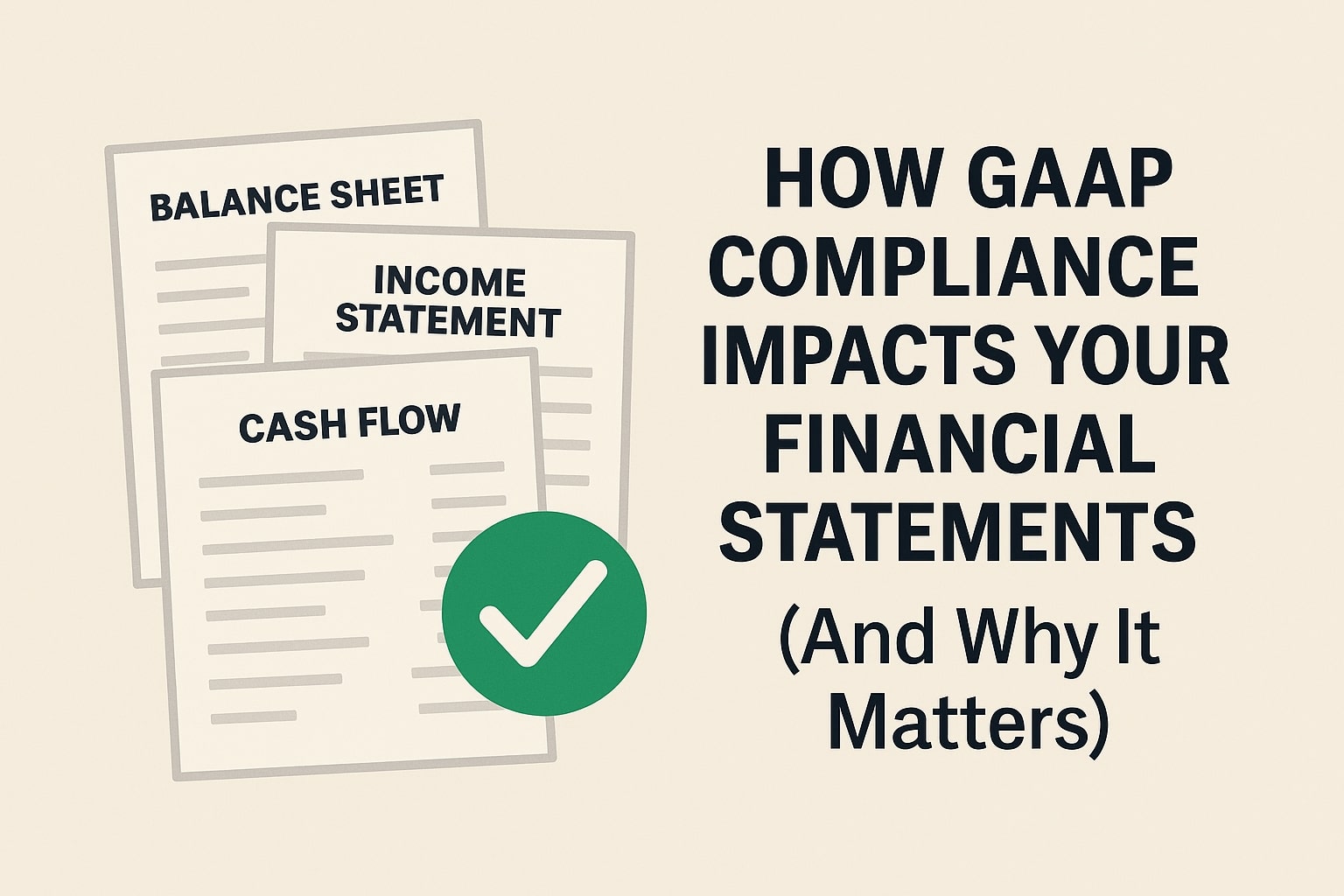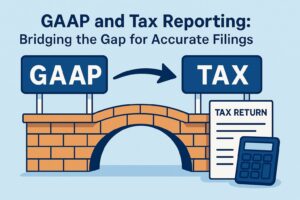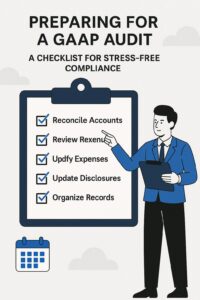Article 4: “How GAAP Compliance Impacts Your Financial Statements (And Why It Matters)”
(Meta Description: Learn how GAAP compliance shapes your balance sheet, income statement, and cash flow. Discover why adherence to GAAP standards is vital for credibility, audits, and growth.)

How GAAP Compliance Impacts Your Financial Statements (And Why It Matters)
Financial statements are the heartbeat of your business—they reveal profitability, liquidity, and long-term viability. But without a standardized framework like GAAP (Generally Accepted Accounting Principles), these reports can be misleading, inconsistent, or even unreliable. In this guide, we’ll explore how GAAP compliance directly impacts your balance sheet, income statement, and cash flow, and why it’s non-negotiable for earning stakeholder trust and avoiding legal pitfalls.
GAAP’s Role in Financial Reporting
GAAP serves as the “rulebook” for preparing financial statements in the U.S. By mandating consistency, transparency, and comparability, it ensures that:
Investors can trust the numbers.
Lenders accurately assess risk.
Businesses meet regulatory requirements.
Let’s break down how GAAP shapes each core financial statement.
1. GAAP’s Impact on the Balance Sheet
The balance sheet provides a snapshot of your company’s assets, liabilities, and equity at a specific time. GAAP compliance affects it in three key ways:
a) Asset Valuation
Cost Principle: Assets are recorded at their original purchase price, not current market value.
Example: A delivery van bought for 30,000 𝑖𝑛 2020 𝑟𝑒𝑚𝑎𝑖𝑛𝑠 𝑣𝑎𝑙𝑢𝑒𝑑 𝑎𝑡 30,000 in 2020 remains valued at 30,000 (minus depreciation), even if its market value drops to $20,000.
Exceptions: Investments (e.g., stocks) are recorded at fair value under GAAP.
b) Liability Reporting
Full Disclosure: All liabilities—including contingent ones like lawsuits—must be disclosed in footnotes.
Example: A pending $50,000 lawsuit is noted, even if the outcome is uncertain.
c) Equity Accuracy
Retained Earnings: GAAP’s matching principle ensures profits/losses are accurately reflected in equity.
Non-GAAP Risk: Overvaluing assets or hiding liabilities can inflate equity, misleading investors.
2. GAAP’s Impact on the Income Statement
The income statement shows revenue, expenses, and profits over a period. GAAP enforces two critical rules here:
a) Revenue Recognition
Revenue is recorded when earned, not when cash is received.
Example: A SaaS company recognizes monthly subscription revenue as services are delivered, even if the customer pays annually upfront.
b) Matching Principle
Expenses are matched to the revenue they help generate.
Example: A bakery records flour costs in the same month as bread sales, not when the flour was purchased.
Non-GAAP Risk: Recognizing revenue too early (e.g., before project completion) can overstate profits and attract regulatory scrutiny.
3. GAAP’s Impact on the Cash Flow Statement
The cash flow statement tracks cash inflows/outflows from operations, investing, and financing. GAAP requires:
a) Indirect Method for Operating Activities
Start with net income and adjust for non-cash items (e.g., depreciation) and changes in working capital.
Example: A $10,000 depreciation expense is added back to net income since it doesn’t impact cash.
b) Clear Categorization
Separating operating, investing, and financing activities prevents confusion.
Example: A loan payment is a financing activity, not an operating expense.
Non-GAAP Risk: Mixing cash flows misleads stakeholders about liquidity.
Why GAAP Compliance Matters Beyond the Numbers
1. Audits and Legal Compliance
Public companies must use GAAP. Private companies adopting GAAP face fewer hurdles during audits or mergers.
The SEC penalizes GAAP violations (e.g., misstated revenues).
2. Stakeholder Trust
Investors rely on GAAP-compliant reports to compare companies.
Lenders use them to approve loans or set interest rates.
3. Strategic Decision-Making
GAAP-compliant data reveals true profitability, helping you allocate resources wisely.
GAAP vs. Non-GAAP Financials: A Side-by-Side Comparison
Aspect
GAAP-Compliant
Non-GAAP
Revenue Timing
Recognized when earned
May recognize when cash is received
Expense Matching
Matched to related revenue
Recorded when paid
Asset Valuation
Historical cost (with exceptions)
Often uses market value
Transparency
High (detailed footnotes)
Low (limited disclosures)
Case Study: How GAAP Saved a Small Business
Background: A manufacturing startup used cash-basis accounting, reporting high profits during a growth spurt. However, they hadn’t recorded $200,000 in pending equipment purchases (accrued liabilities).
Issue: When seeking a loan, the bank requested GAAP-compliant statements. After switching to accrual accounting:
Profits dropped due to matched expenses.
Liabilities increased, revealing lower net equity.
Outcome: The bank approved a smaller loan but praised their transparency. The company later secured investors by show casing GAAP-compliant growth trends.
How to Ensure GAAP Compliance
Use GAAP-Specific Software: QuickBooks, Xero, or Sage Intacct automate accruals and disclosures.
Monthly Reconciliations: Ensure transactions align with GAAP principles.
Hire a CPA: Professionals catch errors like improper revenue recognition.
Stay Updated: FASB updates standards annually (e.g., 2024 lease accounting changes).
FAQs About GAAP and Financial Statements
Q: Is GAAP mandatory for private companies?
A: No, but it’s recommended for businesses seeking loans, investors, or planning to sell.
Q: Can GAAP reports differ from tax returns?
A: Yes! Tax filings follow IRS rules. Reconciling both is key (see our GAAP vs. Tax-Basis guide).
Q: How does GAAP handle intangible assets?
A: Intangibles (e.g., patents) are amortized over their useful life.
Final Thoughts
GAAP compliance isn’t just about checking boxes—it’s about painting an accurate, trustworthy picture of your business. Whether you’re sharing reports with investors or applying for a loan, GAAP-compliant financial statements signal professionalism, accountability, and long-term vision.
(Word count: 1,480 | Primary keywords: GAAP compliance, financial statements, balance sheet, income statement)
SEO & Readability Tips:
Internal Links: Link to related articles (e.g., “Top 10 GAAP Principles” and “GAAP vs. Tax-Basis Accounting”).
Header Hierarchy: Use H2s for sections (e.g., “Impact on Balance Sheet”) and H3s for subsections (e.g., “Asset Valuation”).
Bullet Points/Examples: Break down complex topics for skimmability.




